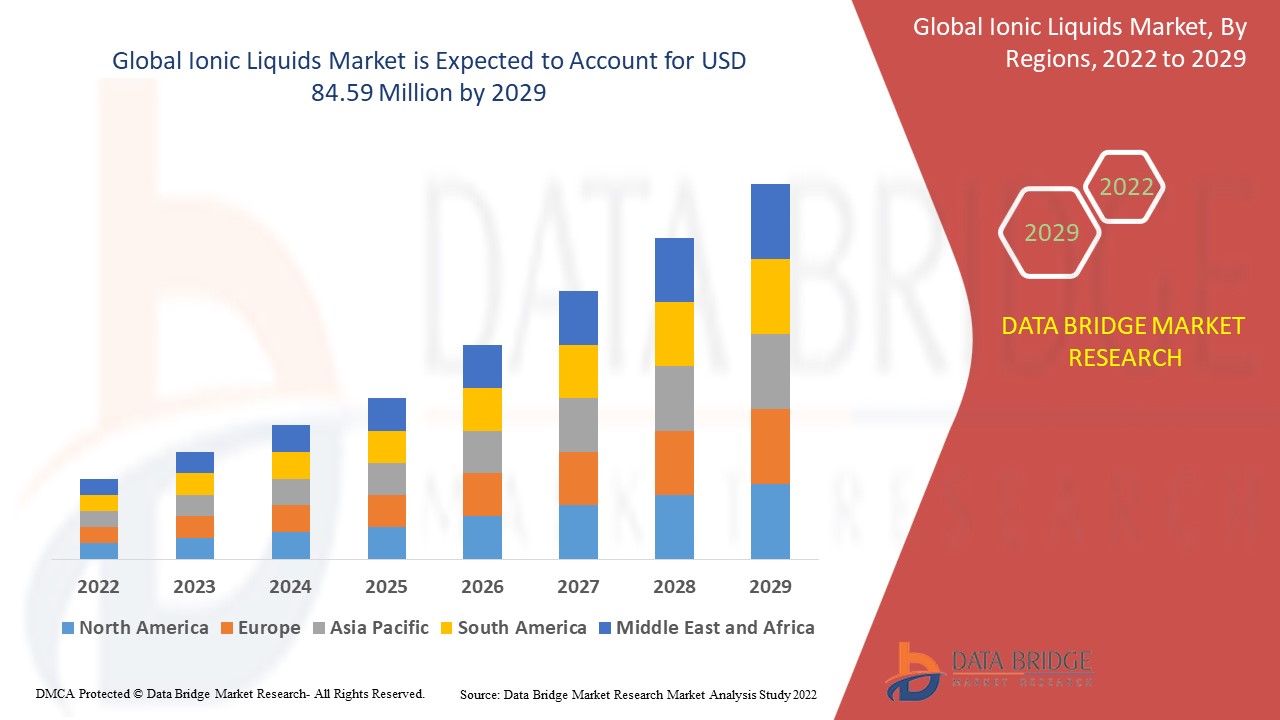Global Ionic Liquid Market
市场规模(十亿美元)
CAGR :
% 
| 2022 –2029 | |
| USD 40.04 Million | |
| USD 84.59 Million | |
|
|
|
|
全球离子液体市场,按产品类型(铵、咪唑、磷、吡咯烷、吡啶等)、应用(工艺化学品、性能化学品)、最终用途行业(溶剂和催化剂、塑料、电化学和电池、生物精炼厂、电子、造纸和纸浆、生物技术、食品、制药等)划分 - 行业趋势和预测至 2029 年

离子液体市场分析及规模
汽车和消费品等终端使用行业的大幅增长(主要归因于经济增长和人口增长)应会推动化学行业的发展,从而增加对离子液体的需求。制造业不断努力降低化学反应的活化能,实现成本节约、产量提高、能源效率和环境法规合规性,应会增加催化剂的使用。
Data Bridge Market Research 分析称,2021 年离子液体市场价值为 4004 万美元,预计到 2029 年将达到 8459 万美元,预测期内(2022-2029 年)的复合年增长率为 9.80%。除了对市场价值、增长率、细分、地理覆盖范围和主要参与者等市场情景的洞察外,Data Bridge Market Research 策划的市场报告还包括深入的专家分析、按地理代表的公司生产和产能、分销商和合作伙伴的网络布局、详细和更新的价格趋势分析以及供应链和需求的缺口分析。
报告范围和市场细分
|
报告指标 |
细节 |
|
预测期 |
2022 至 2029 年 |
|
基准年 |
2021 |
|
历史岁月 |
2020(可定制为 2014 - 2019) |
|
定量单位 |
收入(百万美元)、销量(单位)、定价(美元) |
|
涵盖的领域 |
产品类型(铵、咪唑、磷、吡咯烷、吡啶等)、应用(工艺化学品、性能化学品)、最终用途行业(溶剂和催化剂、塑料、电化学和电池、生物精炼厂、电子、造纸和纸浆、生物技术、食品、制药、其他) |
|
覆盖国家 |
北美洲的美国、加拿大和墨西哥、德国、法国、英国、荷兰、瑞士、比利时、俄罗斯、意大利、西班牙、土耳其、欧洲其他地区、中国、日本、印度、韩国、新加坡、马来西亚、澳大利亚、泰国、印度尼西亚、菲律宾、亚太地区 (APAC) 的其他地区、沙特阿拉伯、阿联酋、南非、埃及、以色列、中东和非洲 (MEA) 的其他地区、巴西、阿根廷和南美洲其他地区 |
|
涵盖的市场参与者 |
塞拉尼斯公司(美国)、帝斯曼(荷兰)、沙特基础工业公司(沙特阿拉伯)、Avient(美国)、陶氏(美国)、恩欣格(德国)、钟化株式会社(日本)、东丽工业株式会社(日本)、三菱工程塑料株式会社(日本)、朗盛(德国)、Imerys(法国)、海拉股份有限公司(德国)、科思创股份公司(德国)、普立万公司(美国)、杜邦公司(美国)、圣戈班公司(法国)、亨斯迈国际有限公司(美国)、Woodbridge(加拿大)、万华化学(中国)和 RTP 公司(美国) |
|
机会 |
|
市场定义
离子液体是一种在低于 100°C 的温度下呈液态的盐类矿物质。它们也被称为室温离子液体,因为它们的熔点通常低于 100°C。离子液体以前曾被引入作为绿色反应介质替代品,因为它们具有独特的物理和化学性质,例如热稳定性、电导性、低蒸气压、抗氧化等。
全球离子液体市场动态
驱动程序
- 环境问题和离子液体在生物质转化中的应用
美国环境保护署 (EPA) 和欧盟等政府机构制定了环境法规,通过减少环境中的挥发性有机化合物 (VOC) 含量来控制毒性,预计这些法规将对绿色溶剂中的离子液体市场产生积极影响。此外,离子液体在将生物质转化为生物燃料和其他化学产品中的应用,特别是将木材分馏成半纤维素、木质素和纤维素等主要成分,目前已成为全球离子液体研究的主要焦点。因此,预计对离子液体的需求将上升,从而推动预测期内全球离子液体市场的发展。
- 离子液体在各种终端使用行业中的可用性高
室内设计市场的扩张推动了离子液体市场的发展,因为离子液体被广泛用于家具涂料。推动离子液体市场发展的另一个因素是可支配收入。发展中国家的工业化也促进了离子液体市场的增长。此外,粘合剂、油墨和化学加工领域的进步占离子液体消费的很大一部分,并充当了离子液体市场的助推器。制药、纺织和农业行业的最新进展对离子液体市场产生了积极影响。推动全球离子液体市场发展的另一个因素是传统溶剂需求的下降。
机会
溶剂和催化剂的应用日益广泛、离子液体的独特性质、萃取和分离行业的需求不断增长以及人们对绿色溶剂的环保意识日益增强,这些都是可能推动市场增长的一些因素。另一方面,应用商业化协会将促进各种机会,从而在预测期内推动市场增长。
限制
高产品成本将限制市场增长,而离子液体及其应用的商业化将在预测期内对市场增长构成挑战。
本离子液体市场报告详细介绍了最新发展、贸易法规、进出口分析、生产分析、价值链优化、市场份额、国内和本地市场参与者的影响,分析了新兴收入领域的机会、市场法规的变化、战略市场增长分析、市场规模、类别市场增长、应用领域和主导地位、产品批准、产品发布、地域扩展、市场技术创新。如需了解有关离子液体市场的更多信息,请联系 Data Bridge Market Research 获取分析师简报,我们的团队将帮助您做出明智的市场决策,实现市场增长。
原材料短缺和运输延误的影响和当前市场状况
Data Bridge Market Research 提供高水平的市场分析,并通过考虑原材料短缺和运输延误的影响和当前市场环境来提供信息。这意味着评估战略可能性、制定有效的行动计划并协助企业做出重要决策。
除了标准报告外,我们还提供从预测的运输延迟、按区域划分的分销商映射、商品分析、生产分析、价格映射趋势、采购、类别绩效分析、供应链风险管理解决方案、高级基准测试等角度对采购层面的深入分析,以及其他采购和战略支持服务。
COVID-19 影响离子液体市场
在新冠疫情期间,各国政府采取谨慎措施,导致离子液体的生产和分销暂时停止,导致终端用户行业受到影响。然而,人们对人类和环境安全的认识不断提高,有助于市场增长,因为使用离子液体可以预防各种环境危害,而且由于其绿色化学性质,对环境友好。
经济放缓对产品定价和供应的预期影响
当经济活动放缓时,行业开始受到影响。DBMR 提供的市场洞察报告和情报服务考虑了经济衰退对产品定价和可获得性的预测影响。借助这些,我们的客户通常可以领先竞争对手一步,预测他们的销售额和收入,并估算他们的盈亏支出。
全球离子液体市场范围
离子液体市场根据产品类型、应用和最终用途行业进行细分。这些细分市场之间的增长将帮助您分析行业中增长微弱的细分市场,并为用户提供有价值的市场概览和市场洞察,帮助他们做出战略决策,确定核心市场应用。
产品类型
- 铵
- 咪唑
- 磷
- 吡咯烷
- 吡啶
- 其他的
应用
- 工艺化学品
- 性能化学品
最终用户
- 溶剂和催化剂
- 塑料
- 电化学与电池
- 生物精炼厂
- 电子产品
- 纸张和纸浆
- 生物技术
- 食物
- 药品
- 其他的
离子液体市场区域分析/见解
对离子液体市场进行了分析,并按国家、产品类型、应用和最终用途行业提供了市场规模见解和趋势,如上所述。
离子液体市场报告涉及的国家包括北美的美国、加拿大和墨西哥、欧洲的德国、法国、英国、荷兰、瑞士、比利时、俄罗斯、意大利、西班牙、土耳其、欧洲其他地区、中国、日本、印度、韩国、新加坡、马来西亚、澳大利亚、泰国、印度尼西亚、菲律宾、亚太地区 (APAC) 的其他地区、沙特阿拉伯、阿联酋、南非、埃及、以色列、中东和非洲 (MEA) 的其他地区、南美洲的巴西、阿根廷和南美洲其他地区
由于印度和中国等发展中国家对催化剂和溶剂的需求不断增长,且该地区拥有大量化学品制造商,因此亚太地区在离子液体市场占据主导地位。
报告的国家部分还提供了影响市场当前和未来趋势的各个市场影响因素和市场监管变化。下游和上游价值链分析、技术趋势和波特五力分析、案例研究等数据点是用于预测各个国家市场情景的一些指标。此外,在提供国家数据的预测分析时,还考虑了全球品牌的存在和可用性以及它们因来自本地和国内品牌的大量或稀缺竞争而面临的挑战、国内关税和贸易路线的影响。
竞争格局和离子液体市场份额分析
离子液体市场竞争格局按竞争对手提供详细信息。详细信息包括公司概况、公司财务状况、收入、市场潜力、研发投资、新市场计划、全球影响力、生产基地和设施、生产能力、公司优势和劣势、产品发布、产品宽度和广度、应用主导地位。以上提供的数据点仅与公司对离子液体市场的关注有关。
离子液体市场的一些主要参与者包括:
- 塞拉尼斯公司(美国)
- 帝斯曼(荷兰)
- SABIC(沙特阿拉伯)
- Avient(美国)
- 陶氏(美国)
- 恩欣格(德国)
- KANEKA株式会社(日本)
- 东丽工业株式会社(日本)
- 三菱工程塑料株式会社(日本)
- 朗盛(德国)
- Imerys(法国)
- HELLA GmbH & Co. KGaA(德国)
- 科思创股份公司 (德国)
- 普立万公司 (美国)
- 杜邦(美国)
- 圣戈班(法国)
- 亨斯迈国际有限责任公司(美国)
- 伍德布里奇(加拿大)
- 万华(中国)
- RTP 公司(美国)
SKU-
Get online access to the report on the World's First Market Intelligence Cloud
- Interactive Data Analysis Dashboard
- Company Analysis Dashboard for high growth potential opportunities
- Research Analyst Access for customization & queries
- Competitor Analysis with Interactive dashboard
- Latest News, Updates & Trend analysis
- Harness the Power of Benchmark Analysis for Comprehensive Competitor Tracking
研究方法
Data collection and base year analysis are done using data collection modules with large sample sizes. The stage includes obtaining market information or related data through various sources and strategies. It includes examining and planning all the data acquired from the past in advance. It likewise envelops the examination of information inconsistencies seen across different information sources. The market data is analysed and estimated using market statistical and coherent models. Also, market share analysis and key trend analysis are the major success factors in the market report. To know more, please request an analyst call or drop down your inquiry.
The key research methodology used by DBMR research team is data triangulation which involves data mining, analysis of the impact of data variables on the market and primary (industry expert) validation. Data models include Vendor Positioning Grid, Market Time Line Analysis, Market Overview and Guide, Company Positioning Grid, Patent Analysis, Pricing Analysis, Company Market Share Analysis, Standards of Measurement, Global versus Regional and Vendor Share Analysis. To know more about the research methodology, drop in an inquiry to speak to our industry experts.
可定制
Data Bridge Market Research is a leader in advanced formative research. We take pride in servicing our existing and new customers with data and analysis that match and suits their goal. The report can be customized to include price trend analysis of target brands understanding the market for additional countries (ask for the list of countries), clinical trial results data, literature review, refurbished market and product base analysis. Market analysis of target competitors can be analyzed from technology-based analysis to market portfolio strategies. We can add as many competitors that you require data about in the format and data style you are looking for. Our team of analysts can also provide you data in crude raw excel files pivot tables (Fact book) or can assist you in creating presentations from the data sets available in the report.




